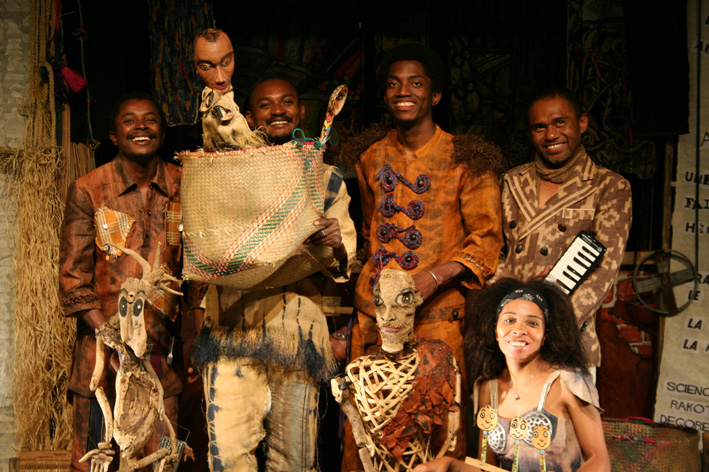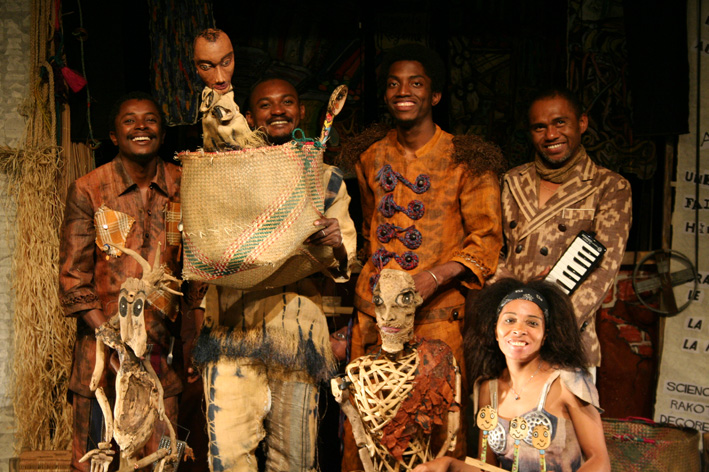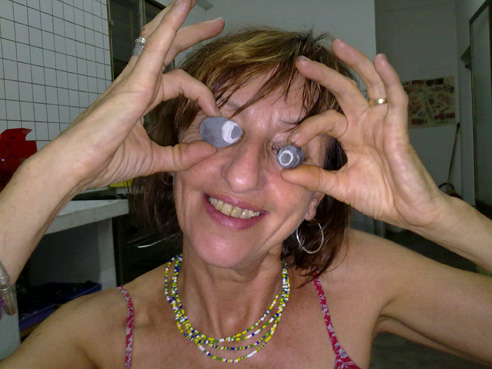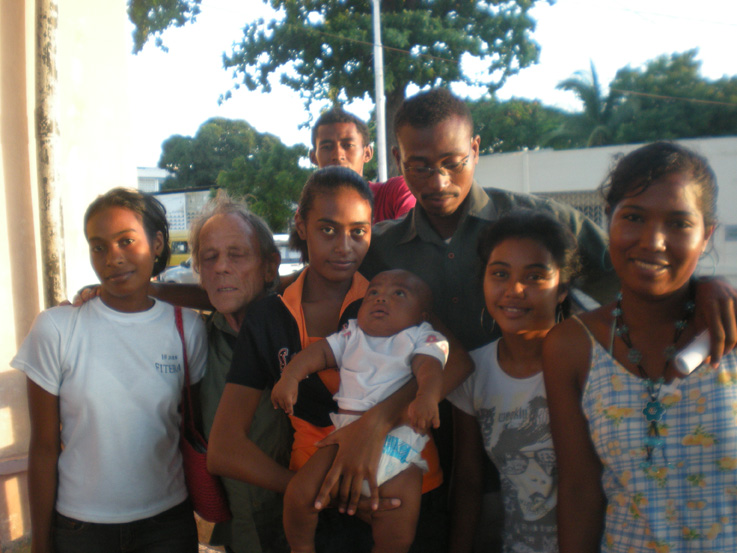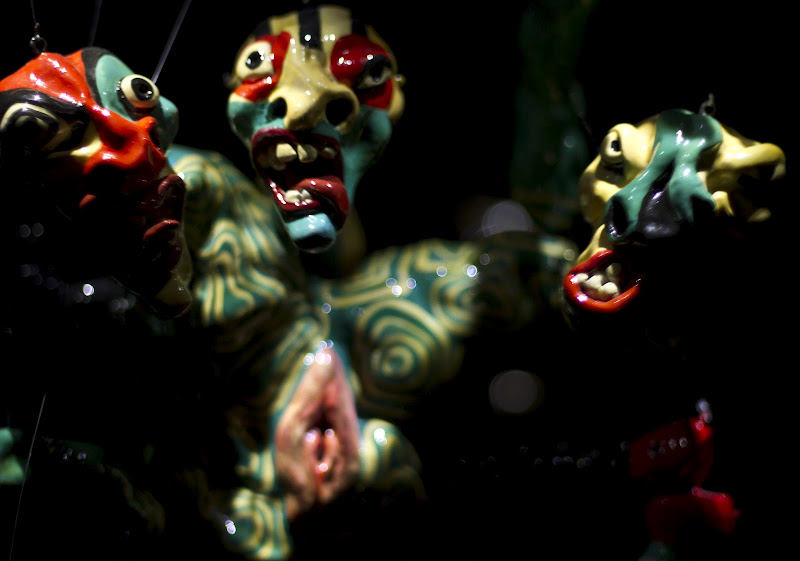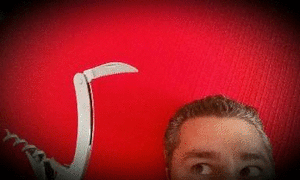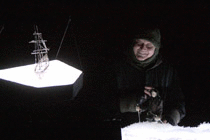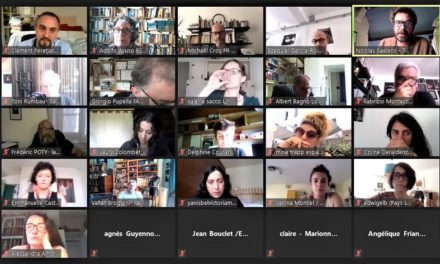“Quel Bazar!” (What chaos!) is the title of the show presented in 2011 at the International Puppet Festival in Charleville Mezières, by Cie Kel’Bazar of Madagascar. The intention of this show is to describe, in a entertaining way, an island that is constantly ignored by the Western media and which is the victim of political appetites that, for many years now, have prevented its people from taking full advantage of the island’s natural resources and of their own incredible vitality. Kel’Bazar is the first professional Malagasy puppet company that has been able to produce a show for a renowned, international festival … But let’s go back in time a bit.
Kel Bazar Company
IIn the summer of 2008 I decided to leave the Guignol Theatre in Lyon after seventeen years of, I belive, good and loyal service, and devote myself entirely to the task of saving the iconic character of Guignol from falling into disgrace among the apologists of modernity. When I set out to rediscover the land of my ancestors, I did so with open arms, carrying in my suitcase my two companions made of wood, like any self-respecting Guignol performer.
If there’s something surprising about Madagascar it’s the coincidences and reencounters that happen. For example, nine times out of ten you will meet someone who will know your closest friends, or who will offer help when you most need it.
In short, after two months of happy and carefree adventures through this country, I met Myriam Merch,, a Belgian artist who had lived for twenty years in Madagascar. With incredible speed she “lémurifla” (bewitched) me, as she likes to say and do, for her shows are shot through with jumping lemurs, smells of the bazaar and Malagasy smiles. And then the most incredible thing of the journey occured, when I realised that the traditional glove puppet was very little (I don’t dare to say un-) known.
Myriam Merch
It was in Antananarivo, on the bustling steps of the Analakely market area. It was hot and I had walked, under a blazing sun, further than my legs could bear.
I decided to sit there on the steps, something that surprised more than a few people. How can a Malagasy or half-vazahy (half-white) take a seat there? My eyes encountered circumspect smiles, smiles that I returned to incredulous looks. Gnafron stuck his head out of my bag to show his face to the kids on the street, timidly at first, sinking his bright round eyes in the bright eyes of the children, until he finally had the use of my whole arm. Gesticulating, waving, shaking his sleeves; before a crowd that was ever growing, addressed by this fun little white being with a red nose and placid smile. The laughter and whispers grew until they turned into a roar.
Hardly five minutes after this improvised, wordless show, I had to take the rapid decision to put away the piece of wood and leave in a hurry, because the bottleneck on the steps was becoming worrying as dozens of people pressed against each other to see what was happening. I walked through the crowd and disappeared at the top of the steps in order to hide from my young “pursuers,” for which reason I plunged into a bar in the street below. There, in front of a local beer, I took note that there was a future for traditional puppets, and that in the land of my birth, perhaps I would find a way to get what I was in search of.
Transmission.
I was all confused. The words tradition and modernity clashed constantly. Wasn’t this the heart of the matter? Had I not just brought novelty and modernity to the Analakely steps, through an object that is judged (erroneously) to be old-fashioned and outdated? But the most important thing for me, one of “the tribe of those who raise their arms to heaven”, in early retirement, was to get an idea of ??the situation concerning puppets in Madagascar. Could it be that there was actually no situation at all?
Thanks to Myriam, I learned that there was a company in the north who had a repertoire of two rod puppets shows, financed by an NGO, and that there had been another famous company in the south, whose leader, she thought or believed, had died. Later we realized that there were, here and there, a number of groups of modest means who did small shows when NGOs offered them the opportunity.
Given that my trip was coming to an end, it was necessary to act fast. I was able to make use of Myriam’s extraordinary network of contacts, but also that of Jean Luc Colin (a great improviser and a friend from Lyon), and, furthermore, of the friendship and help of Johary Ravaloson (known and renowned Malagasy author), attracted perhaps by the possibility of meeting artists with new techniques. Together we created Bazar kel’y (small bazaar), a Malagasy association whose objective is to train people in fine arts, in puppet construction and manipulation, and improvisational theatre. Back in France, we mounted another Kel’Bazar, whose mission was to raise funds in order to keep the first one alive.
Then things accelerated. With the support of what was the Albert Camus Cultural Centre, – now a French institute, run at that time by Bérénice Gulman -, of Art Mada (French cultural organization aimed at professional training in collaboration with the Malagasy Ministry of Culture), and with the encouragement of Agnes Clauss and the approval of Laurent Devathaire, then director of the Alliance Francaise de Toomasina (Tamavate), in June 2009 it was possible to set up a training course with twenty participants from four regions. The condition was that during the workshop we would recruit five artists to participate in the creation of a show.
The training workshop was a success because, besides being the starting point for the adventure of the show “Quel Bazar!” (What chaos!), it also favoured the emergence of several small groups which, since then, have made proposals for events funded by NGOs, in which the (traditional) puppet plays an important role. Later, in 2010 and 2011, two workshops were held at the Alliance Francaise de Mahajunda, giving rise to a small company that has already mounted a twenty-minute work that is being shown in local schools.
Today we constantly create projects such as organising an international travelling puppet festival, or the creation of a television program. However, I have been forced (for now) to keep our ambitions in check, since, in order to bring to fruition a project of this magnitude strong support from institutions is necessary but so, too, is time and patience … Because the truth is that, although in only three years we have done some interesting things and puppets have become a little more visible, the artists have both the need and desire to learn, to know, to appropriate the puppet as a new mode of expression.
In all modesty, I cannot offer more than a small piece of that huge pie … To the best of my, and our, possibilities, we are persevering in this work and dream of a Malagasy festival that respects local artists, whose place we have no intention of claiming, much less occupying; rather, our goal is to let them act in a way that is to their liking … It will take time, as anyone can tell you who knows Madagascar and its “mora-mora” (slowly, slowly), which sets the pace for everything that is done.
At any rate, I will always remember the birth of the glove puppet on the steps of Analakely.
Filip Auchère
Lyon, pancake day, February 2012

